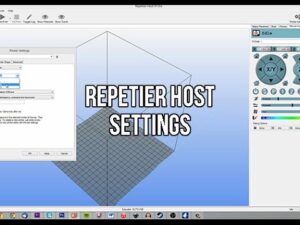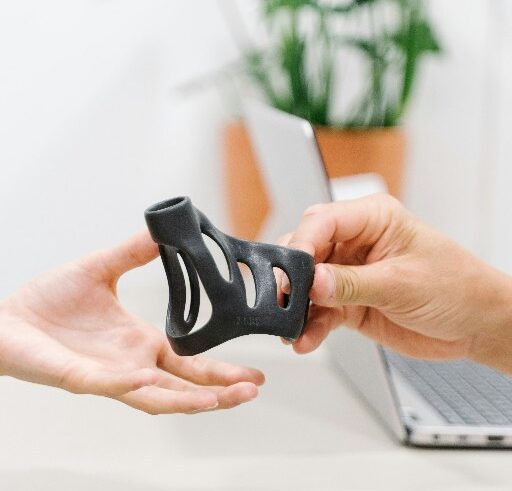Repetier Firmware in 3D Printing
Muhammad Yamin
Faculty of Agricultural Engineering & Technology, University of Agriculture, Faisalabad, Pakistan
Repetier firmware stands as a competitive player in the area of precision-driven additive manufacturing i.e. 3D printing, offering a versatile and dynamic platform for enthusiasts and professionals alike. Repetier firmware boasts compatibility with a wide range of 3D printers, including popular models like the Prusa i3 series, Creality Ender 3 and 5, and many more.
Configuration Flexibility
One of the standout features of Repetier firmware lies in its unparalleled configuration flexibility. Tailoring a 3D printer to specific needs often requires fine-tuning various parameters, and Repetier firmware excels in providing an extensive range of customizable settings. From steps per millimeter to acceleration profiles, users have granular control over every aspect of their printer, empowering them to achieve optimal print quality. Users can adjust retraction distance, filament flow rate, print speed, cooling fan settings, and even define custom starting and ending G-code scripts for intricate print processes.
For experienced users, Repetier firmware unlocks even deeper customization options through the use of M-codes. M-codes are machine code commands specifically designed for 3D printers. Repetier firmware allows users to define and integrate custom M-code scripts into their printing profiles. This enables precise control over various printer functions beyond the standard settings offered by the firmware. Examples of M-code applications include:
M104: Set extruder temperature.
M106: Set fan speed.
M107: Turn off the heated bed.
G28: Home the printer axes.
By incorporating custom M-code scripts, users can automate specific printing tasks, perform filament purges or implement bed leveling adjustments at the start of a print. This advanced level of control empowers users to perform intricate printing processes and unlock the full potential of their 3D printer.
Multi-Extruder Support
Repetier firmware seamlessly accommodates the demands of multi-extruder setups, a crucial feature for those venturing into complex 3D printing projects. With the ability to control multiple extruders independently, users can experiment with diverse filaments and colors within a single print job. This capability expands the creative possibilities and practical applications of 3D printing, from intricate multi-color designs to functional prototypes with dissolvable support structures.
Advanced Heating and Cooling Management
Efficient temperature control is paramount for successful 3D printing. Repetier firmware excels in this domain by offering advanced heating and cooling management. Users can precisely regulate extruder and bed temperatures, ensuring optimal conditions for different filament materials. Additionally, the firmware supports fan speed control, contributing to the fine-tuning required for achieving a good print quality.
Repetier Host: The Complementary Companion
To unlock the full potential of Repetier firmware, users often turn to Repetier Host, a powerful software that acts as a bridge between the user and the 3D printer. Repetier Host facilitates the slicing of 3D models, generating the G-code necessary for the printer to execute the print job.

More than just a slicer, Repetier Host provides an intuitive interface for users to monitor and control their 3D printers. It offers real-time visualization of the print, allowing users to observe each layer as it takes shape. This level of visibility is crucial for identifying any anomalies during the printing process.
Integration for Power Loss Recovery
The synergy between Repetier firmware and Repetier Host manifests most prominently in the seamless integration for power loss recovery. The host software communicates with the firmware, ensuring that the last recorded state of the print is accurately preserved. In case of a power outage, Repetier Host automatically saves the print’s progress and printer settings. Upon restarting the printer and software, users can seamlessly resume the print from the exact point of interruption, minimizing wasted filament and time. This integration of Repetier firmware and Repetier Host simplifies the user experience, offering a streamlined solution for managing unexpected disruptions.
Extensive Community Support
The strength of any firmware lies not only in its features but also in the community that surrounds it. Repetier firmware benefits from a vibrant and engaged user community. The Repetier community thrives on active forums, online repositories like https://github.com/repetier/Repetier-Firmware, and dedicated websites where users can find troubleshooting guides, custom firmware versions, and printer profiles created by the community. This ecosystem fosters knowledge-sharing, troubleshooting assistance, and the continuous evolution of the firmware through collaborative efforts. The robust community support adds a layer of reliability to Repetier firmware, making it an appealing choice for both newcomers and seasoned 3D printing enthusiasts.
Conclusion
In the intricate world of 3D printing, Repetier firmware stands as a reliable companion, offering a feature-rich and flexible platform for users to realize their printing aspirations. From meticulous configuration control to support for multi-extruder setups and real-time monitoring, Repetier firmware encapsulates the essence of precision and adaptability. As the 3D printing landscape continues to evolve, Repetier firmware remains a stalwart choice, empowering users to push the boundaries of creativity and achieve unparalleled precision in their additive manufacturing endeavors.







Effectively highlighted the key benefits and features of Repetier firmware, showcasing its value in the 3D printing community. Well described and informative.
This comparison helps a person to choose a software for 3D according to his need and considerations. As a student who is just a beginner will choose repetier while a professional expert will choose Marlin which help to deal with complex problems
This article contain most advanced information, I have learned more about new things by the way of it.